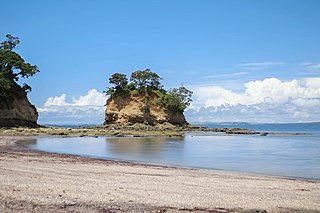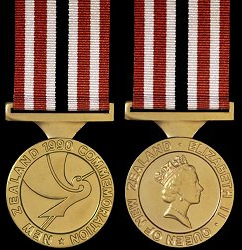Related Research Articles

The North Shore is one of the major geographical regions of Auckland, the largest city in New Zealand. The area is defined as the northern shores of the Waitematā Harbour as far north as the Ōkura River.

Orewa is a settlement in the northern Auckland Region of New Zealand. It is a suburb of the Hibiscus Coast, just north of the base of the Whangaparāoa Peninsula and 40 kilometres (25 mi) north of central Auckland. The Northern Motorway, part of State Highway 1, passes just inland of Orewa and extends through the twin Johnston Hill tunnels to near Puhoi.

East Coast Bays is a string of small suburbs that form the northernmost part of the North Shore, part of the contiguous Auckland metropolitan area in New Zealand. The suburbs line the north-east coast of the city along the shore of the Hauraki Gulf and Rangitoto Channel. They include, from north to south, Long Bay, Torbay, Waiake Bay, Browns Bay, Rothesay Bay, Murrays Bay, Mairangi Bay, Campbells Bay and Castor Bay. Most of the East Coast Bays are covered under the East Coast Bays subdivision of the Hibiscus and Bays local board area.

Birkenhead is a suburb of Auckland, in northern New Zealand. It is located on the North Shore of the Waitematā Harbour, 4 kilometres (2.5 mi) northwest of the Auckland City Centre. The area has been settled by Tāmaki Māori since at least the 14th century, and is the location of Te Matarae ō Mana, a fortified pā for Te Kawerau ā Maki that overlooked an important seasonal shark fishery. European settlement in Birkenhead began in late the 1840s, and by the late 19th century the area became renowned for strawberry crops. In 1884, the Chelsea Sugar Refinery was constructed in Birkenhead, becoming a major source of income for Birkenhead. The increased population growth led to Birkenhead becoming one of the first boroughs of Auckland in 1888. Birkenhead transitioned from a semi-rural community to suburban Auckland after the opening of the Auckland Harbour Bridge in 1959, becoming a city in 1978. In 1989, Birkenhead City was amalgamated with North Shore City.

Milford is a suburb located on the North Shore, Auckland. It is located on northern side of Lake Pupuke. It also has a popular swimming beach, which runs some two kilometres from Black Rock in the south to Castor Bay in the north. The Wairau Creek reaches the sea at the Hauraki Gulf at the northern end of Milford Beach, and its lower tidal reaches host the Milford Marina.

Browns Bay is one of the most northernmost suburbs in the contiguous Auckland metropolitan area, located in the North Shore. Named after the Brown family who settled here in 1876, Browns Bay became a holiday destination in the late 19th century. The area gradually developed into a suburb of Auckland in the 1950s, and was the administrative centre for the East Coast Bays City from 1975 until it was disestablished in 1989. During the 1990s, the suburb became a hub for the South African New Zealander community.

Torbay is a northern suburb of Auckland, New Zealand. It is located in the upper East Coast Bays of the city's North Shore, and is governed by Auckland Council.

Rothesay Bay is a small suburb in Auckland's East Coast Bays region. The suburb is roughly the same size as Murrays Bay, the suburb to the immediate south.

What Becomes of the Broken Hearted? is a 1999 New Zealand drama film directed by Ian Mune and starring Temuera Morrison as an abusive Māori husband, Jake "the Muss" Heke. The film is based on Alan Duff's novel What Becomes of the Broken Hearted? (1996), the sequel to Once Were Warriors (1990), which was made into the film Once Were Warriors (1994).
Ngāti Raukawa is a Māori iwi with traditional bases in the Waikato, Taupō and Manawatu/Horowhenua regions of New Zealand. In 2006, 29,418 Māori registered their affiliation with Ngāti Raukawa.

The New Zealand 1990 Commemoration Medal was a commemorative medal awarded in New Zealand in 1990 to celebrate the 150th anniversary of the signing of the Treaty of Waitangi, and was awarded to 3,632 people.

Sir Edward Taihakurei Durie is a New Zealand jurist who served on the High Court of New Zealand between 1998 and 2004. He was the first Māori appointed as a judge of a New Zealand court.
Diggeress Rangituatahi Te Kanawa was a New Zealand Māori tohunga raranga of Ngāti Maniapoto and Ngāti Kinohaku descent. At the time of her death she was regarded as New Zealand's most renowned weaver.

Hōri Pukehika was a New Zealand Māori tribal leader and woodcarver.
To Love a Maori is a 1972 New Zealand film about an interracial romance. It was the seventh and last feature from Rudall Hayward.
The 2017 New Year Honours in New Zealand were appointments by Elizabeth II in her right as Queen of New Zealand, on the advice of the New Zealand government, to various orders and honours to reward and highlight good works by New Zealanders, and to celebrate the passing of 2016 and the beginning of 2017. They were announced on 31 December 2016.
The 2009 Queen's Birthday Honours in New Zealand, celebrating the official birthday of Queen Elizabeth II, were appointments made by the Queen in her right as Queen of New Zealand, on the advice of the New Zealand government, to various orders and honours to reward and highlight good works by New Zealanders. They were announced on 1 June 2009.
The 2000 New Year Honours in New Zealand were appointments by Elizabeth II in her right as Queen of New Zealand, on the advice of the New Zealand government, to various orders and honours to reward and highlight good works by New Zealanders, and to celebrate the passing of 1999 and the beginning of 2000. They were announced on 31 December 1999.
Pātea Māori Club is a New Zealand cultural group and performance act formed in the South Taranaki town of Pātea in 1967 as the Pātea Methodist Māori Club. In 1983, the group began to release Māori-language pop and hip hop music, produced by Dalvanius Prime with lyrics by Ngoi Pēwhairangi. Their first single, "Poi E", reached number one on the New Zealand top 50 singles chart in 1984.

John Bevan Ford was a New Zealand Māori artist and educator who started exhibiting in 1966. He is a leading figure in contemporary Māori art with art held in all large public collections of New Zealand. In 2005 Ford received the Creative New Zealand Te Waka Toi Kingi Ihaka Award.
References
- ↑ "TV film on Maori youths". The Press. 31 July 1985. Retrieved 3 September 2023– via Papers Past.
- ↑ Martin, Helen; Edwards, Sam (1997). New Zealand film, 1912-1996. Auckland: Oxford University Press. ISBN 0195583361.
- 1 2 "Mark II". NZ On Screen . TVNZ: Ngā Taonga Sound & Vision. 1988. Retrieved 5 January 2023.
- ↑ "Another chance to see 'good-time movie'". The Press. 11 July 1987. Retrieved 3 September 2023– via Papers Past.
- ↑ Shaw, Barry (6 November 1986). "Mark II review". The New Zealand Herald.
- ↑ "Topp Twins score treble in G.O.F.T.A. awards". The Press. 17 July 1987. Retrieved 3 September 2023– via Papers Past.
- ↑ Williams, Paul (13 September 2022). "Former actor Mitch Manuel's artwork exhibited in Scotland to critical acclaim". Horowhenua Chronicle.